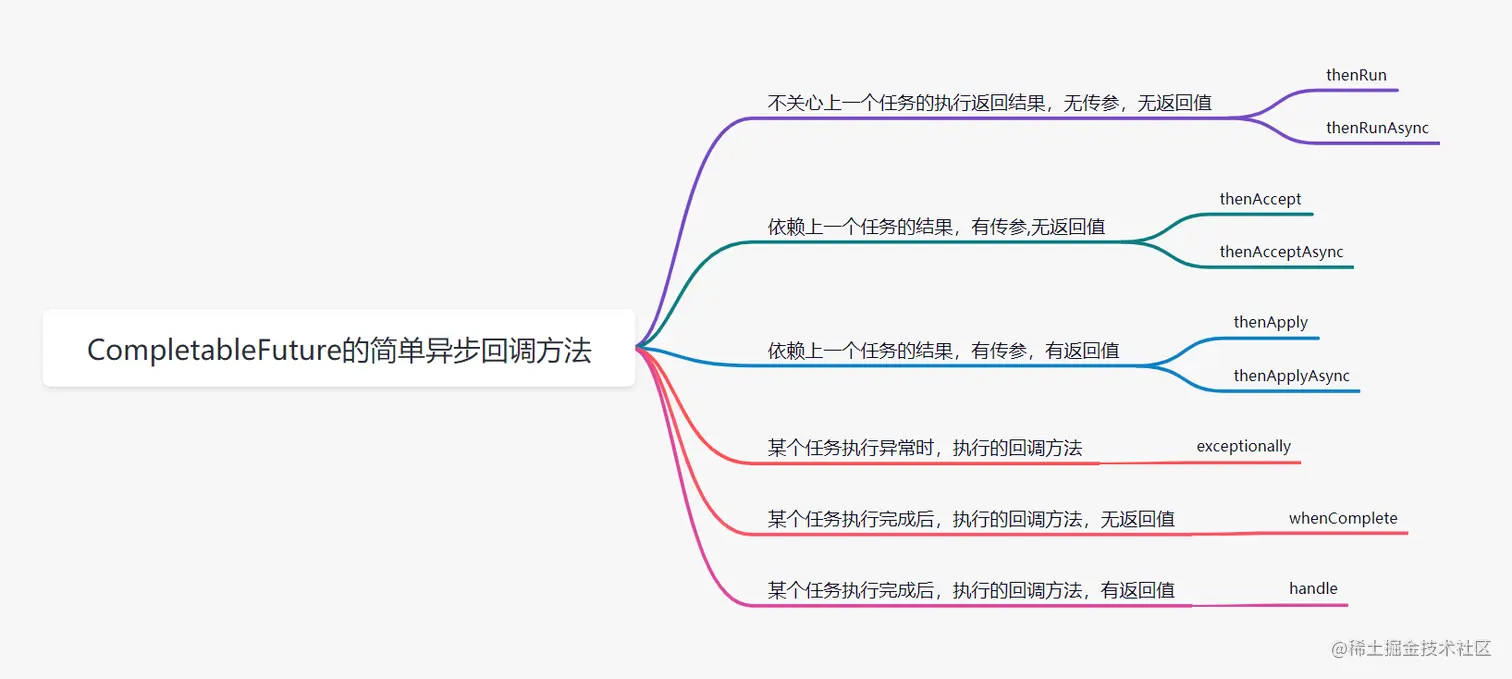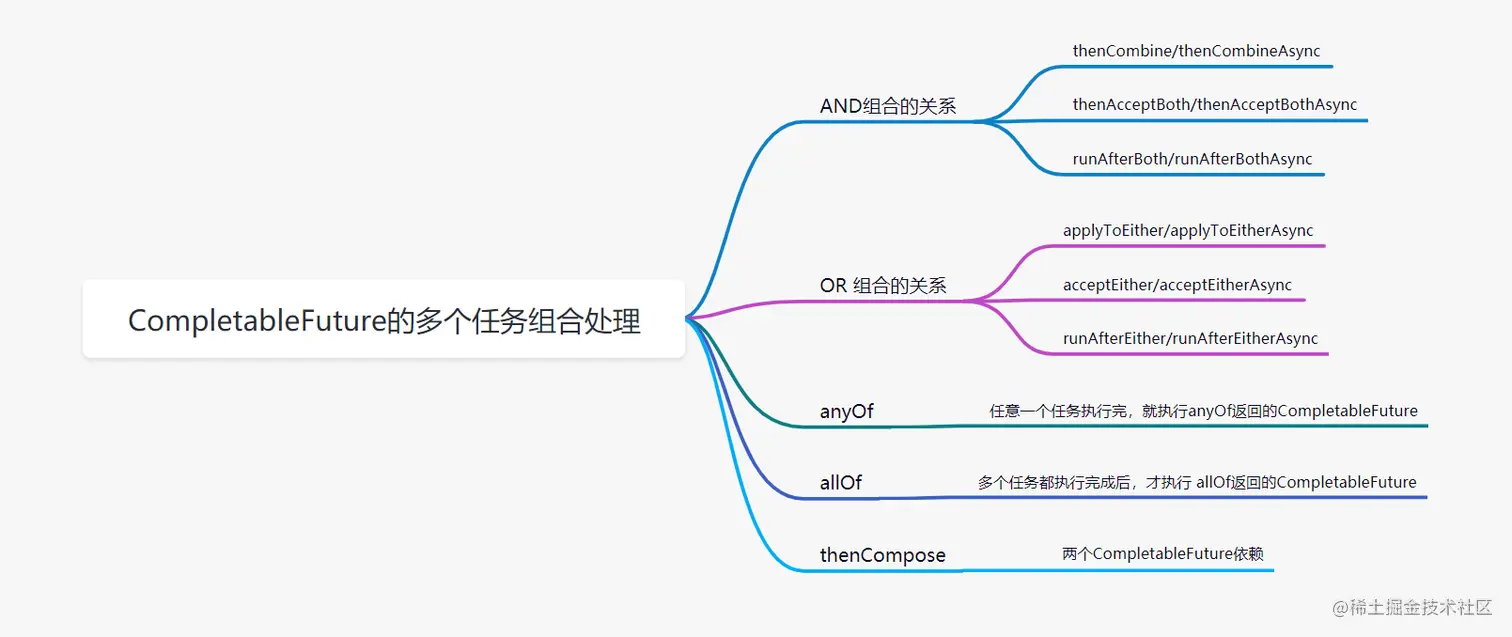CompletableFuture
背景
因为CompletableFuture实现了Future接口,我们先来回顾Future吧。Future是Java5新加的一个接口,它提供了一种异步并行计算的功能。如果主线程需要执行一个很耗时的计算任务,我们就可以通过future把这个任务放到异步线程中执行。主线程继续处理其他任务,处理完成后,再通过Future获取计算结果。 来看个简单例子吧,假设我们有两个任务服务,一个查询用户基本信息,一个是查询用户勋章信息。如下,
public class UserInfoService {
public UserInfo getUserInfo(Long userId) throws InterruptedException {
Thread.sleep(300);//模拟调用耗时
return new UserInfo("666", "Cmyshare", 27); //一般是查数据库,或者远程调用返回的
}
}
public class MedalService {
public MedalInfo getMedalInfo(long userId) throws InterruptedException {
Thread.sleep(500); //模拟调用耗时
return new MedalInfo("666", "守护勋章");
}
}接下来,我们来演示下,在主线程中是如何使用Future来进行异步调用的。
public class FutureTest {
public static void main(String[] args) throws ExecutionException, InterruptedException {
ExecutorService executorService = Executors.newFixedThreadPool(10);
UserInfoService userInfoService = new UserInfoService();
MedalService medalService = new MedalService();
long userId =666L;
long startTime = System.currentTimeMillis();
//调用用户服务获取用户基本信息
FutureTask<UserInfo> userInfoFutureTask = new FutureTask<>(new Callable<UserInfo>() {
@Override
public UserInfo call() throws Exception {
return userInfoService.getUserInfo(userId);
}
});
executorService.submit(userInfoFutureTask);
Thread.sleep(300); //模拟主线程其它操作耗时
FutureTask<MedalInfo> medalInfoFutureTask = new FutureTask<>(new Callable<MedalInfo>() {
@Override
public MedalInfo call() throws Exception {
return medalService.getMedalInfo(userId);
}
});
executorService.submit(medalInfoFutureTask);
UserInfo userInfo = userInfoFutureTask.get();//获取个人信息结果
MedalInfo medalInfo = medalInfoFutureTask.get();//获取勋章信息结果
System.out.println("总共用时" + (System.currentTimeMillis() - startTime) + "ms");
}
}如果我们不使用Future进行并行异步调用,而是在主线程串行进行的话,耗时大约为300+500+300 = 1100 ms。可以发现,future+线程池异步配合,提高了程序的执行效率。 但是Future对于结果的获取,不是很友好,只能通过阻塞或者轮询的方式得到任务的结果。
- Future.get() 就是阻塞调用,在线程获取结果之前get方法会一直阻塞。
- Future提供了一个isDone方法,可以在程序中轮询这个方法查询执行结果。
阻塞的方式和异步编程的设计理念相违背,而轮询的方式会耗费无谓的CPU资源。因此,JDK8设计出CompletableFuture。CompletableFuture提供了一种观察者模式类似的机制,可以让任务执行完成后通知监听的一方。
简介
CompletableFuture是jdk8的新特性。CompletableFuture实现了CompletionStage接口和Future接口,前者是对后者的一个扩展,增加了异步会点、流式处理、多个Future组合处理的能力,使Java在处理多任务的协同工作时更加顺畅便利。CompletableFuture提供了几十种方法,辅助我们的异步任务场景。这些方法包括创建异步任务、任务异步回调、多个任务组合处理等方面。
如何使用
创建异步任务
CompletableFuture创建异步任务,一般有supplyAsync和runAsync两个方法。
- supplyAsync执行CompletableFuture任务,支持返回值
- runAsync执行CompletableFuture任务,没有返回值。
//使用默认内置线程池ForkJoinPool.commonPool(),根据supplier构建执行任务
public static <U> CompletableFuture<U> supplyAsync(Supplier<U> supplier)
//自定义线程,根据supplier构建执行任务
public static <U> CompletableFuture<U> supplyAsync(Supplier<U> supplier, Executor executor)//使用默认内置线程池ForkJoinPool.commonPool(),根据supplier构建执行任务
public static <U> CompletableFuture<U> supplyAsync(Supplier<U> supplier)
//自定义线程,根据supplier构建执行任务
public static <U> CompletableFuture<U> supplyAsync(Supplier<U> supplier, Executor executor)实例代码如下:
public class FutureTest {
public static void main(String[] args) {
//可以自定义线程池
ExecutorService executor = Executors.newCachedThreadPool();
//runAsync的使用
CompletableFuture<Void> runFuture = CompletableFuture.runAsync(() -> System.out.println("run,关注公众号:Cmyshare"), executor);
//supplyAsync的使用
CompletableFuture<String> supplyFuture = CompletableFuture.supplyAsync(() -> {
System.out.print("supply,关注公众号:Cmyshare");
return "Cmyshare"; }, executor);
//runAsync的future没有返回值,输出null
System.out.println(runFuture.join());
//supplyAsync的future,有返回值
System.out.println(supplyFuture.join());
executor.shutdown(); // 线程池需要关闭
}
}
//输出
run,关注公众号:Cmyshare
null
supply,关注公众号:CmyshareCmyshare任务异步回调

1. thenRun/thenRunAsync
public CompletableFuture<Void> thenRun(Runnable action);
public CompletableFuture<Void> thenRunAsync(Runnable action);CompletableFuture的thenRun方法,通俗点讲就是,做完第一个任务后,再做第二个任务。某个任务执行完成后,执行回调方法;但是前后两个任务没有参数传递,第二个任务也没有返回值
public class FutureThenRunTest {
public static void main(String[] args) throws ExecutionException, InterruptedException {
CompletableFuture<String> orgFuture = CompletableFuture.supplyAsync(
()->{
System.out.println("先执行第一个CompletableFuture方法任务");
return "Cmyshare";
}
);
CompletableFuture thenRunFuture = orgFuture.thenRun(() -> {
System.out.println("接着执行第二个任务");
});
System.out.println(thenRunFuture.get());
}
}
//输出
先执行第一个CompletableFuture方法任务
接着执行第二个任务
nullthenRun 和thenRunAsync有什么区别呢?可以看下源码哈:
private static final Executor asyncPool = useCommonPool ?
ForkJoinPool.commonPool() : new ThreadPerTaskExecutor();
public CompletableFuture<Void> thenRun(Runnable action) {
return uniRunStage(null, action);
}
public CompletableFuture<Void> thenRunAsync(Runnable action) {
return uniRunStage(asyncPool, action);
}如果你执行第一个任务的时候,传入了一个自定义线程池:
- 调用thenRun方法执行第二个任务时,则第二个任务和第一个任务是共用同一个线程池。
- 调用thenRunAsync执行第二个任务时,则第一个任务使用的是你自己传入的线程池,第二个任务使用的是ForkJoin线程池
TIPS: 后面介绍的thenAccept和thenAcceptAsync,thenApply和thenApplyAsync等,它们之间的区别也是这个哈。
2.thenAccept/thenAcceptAsync
CompletableFuture的thenAccept方法表示,第一个任务执行完成后,执行第二个回调方法任务,会将该任务的执行结果,作为入参,传递到回调方法中,但是回调方法是没有返回值的。
public class FutureThenAcceptTest {
public static void main(String[] args) throws ExecutionException, InterruptedException {
CompletableFuture<String> orgFuture = CompletableFuture.supplyAsync(
()->{
System.out.println("原始CompletableFuture方法任务");
return "Cmyshare";
}
);
CompletableFuture thenAcceptFuture = orgFuture.thenAccept((a) -> {
if ("Cmyshare".equals(a)) {
System.out.println("关注了");
}
System.out.println("先考虑考虑");
});
System.out.println(thenAcceptFuture.get());
}
}3. thenApply/thenApplyAsync
CompletableFuture的thenApply方法表示,第一个任务执行完成后,执行第二个回调方法任务,会将该任务的执行结果,作为入参,传递到回调方法中,并且回调方法是有返回值的。
public class FutureThenApplyTest {
public static void main(String[] args) throws ExecutionException, InterruptedException {
CompletableFuture<String> orgFuture = CompletableFuture.supplyAsync(
()->{
System.out.println("原始CompletableFuture方法任务");
return "Cmyshare";
}
);
CompletableFuture<String> thenApplyFuture = orgFuture.thenApply((a) -> {
if ("Cmyshare".equals(a)) {
return "关注了";
}
return "先考虑考虑";
});
System.out.println(thenApplyFuture.get());
}
}
//输出
原始CompletableFuture方法任务
关注了4. exceptionally
CompletableFuture的exceptionally方法表示,某个任务执行异常时,执行的回调方法;并且有抛出异常作为参数,传递到回调方法。
public class FutureExceptionTest {
public static void main(String[] args) throws ExecutionException, InterruptedException {
CompletableFuture<String> orgFuture = CompletableFuture.supplyAsync(
()->{
System.out.println("当前线程名称:" + Thread.currentThread().getName());
throw new RuntimeException();
}
);
CompletableFuture<String> exceptionFuture = orgFuture.exceptionally((e) -> {
e.printStackTrace();
return "你的程序异常啦";
});
System.out.println(exceptionFuture.get());
}
}
//输出
当前线程名称:ForkJoinPool.commonPool-worker-1
java.util.concurrent.CompletionException: java.lang.RuntimeException
at java.util.concurrent.CompletableFuture.encodeThrowable(CompletableFuture.java:273)
at java.util.concurrent.CompletableFuture.completeThrowable(CompletableFuture.java:280)
at java.util.concurrent.CompletableFuture$AsyncSupply.run(CompletableFuture.java:1592)
at java.util.concurrent.CompletableFuture$AsyncSupply.exec(CompletableFuture.java:1582)
at java.util.concurrent.ForkJoinTask.doExec(ForkJoinTask.java:289)
at java.util.concurrent.ForkJoinPool$WorkQueue.runTask(ForkJoinPool.java:1056)
at java.util.concurrent.ForkJoinPool.runWorker(ForkJoinPool.java:1692)
at java.util.concurrent.ForkJoinWorkerThread.run(ForkJoinWorkerThread.java:157)
Caused by: java.lang.RuntimeException
at cn.eovie.future.FutureWhenTest.lambda$main$0(FutureWhenTest.java:13)
at java.util.concurrent.CompletableFuture$AsyncSupply.run(CompletableFuture.java:1590)
... 5 more
你的程序异常啦5. whenComplete方法
CompletableFuture的whenComplete方法表示,某个任务执行完成后,执行的回调方法,无返回值;并且whenComplete方法返回的CompletableFuture的result是上个任务的结果。
public class FutureWhenTest {
public static void main(String[] args) throws ExecutionException, InterruptedException {
CompletableFuture<String> orgFuture = CompletableFuture.supplyAsync(
()->{
System.out.println("当前线程名称:" + Thread.currentThread().getName());
try {
Thread.sleep(2000L);
} catch (InterruptedException e) {
e.printStackTrace();
}
return "Cmyshare";
}
);
CompletableFuture<String> rstFuture = orgFuture.whenComplete((a, throwable) -> {
System.out.println("当前线程名称:" + Thread.currentThread().getName());
System.out.println("上个任务执行完啦,还把" + a + "传过来");
if ("Cmyshare".equals(a)) {
System.out.println("666");
}
System.out.println("233333");
});
System.out.println(rstFuture.get());
}
}
//输出
当前线程名称:ForkJoinPool.commonPool-worker-1
当前线程名称:ForkJoinPool.commonPool-worker-1
上个任务执行完啦,还把Cmyshare传过来
666
233333
Cmyshare6. handle方法
CompletableFuture的handle方法表示,某个任务执行完成后,执行回调方法,并且是有返回值的;并且handle方法返回的CompletableFuture的result是回调方法执行的结果。
public class FutureHandlerTest {
public static void main(String[] args) throws ExecutionException, InterruptedException {
CompletableFuture<String> orgFuture = CompletableFuture.supplyAsync(
()->{
System.out.println("当前线程名称:" + Thread.currentThread().getName());
try {
Thread.sleep(2000L);
} catch (InterruptedException e) {
e.printStackTrace();
}
return "Cmyshare";
}
);
CompletableFuture<String> rstFuture = orgFuture.handle((a, throwable) -> {
System.out.println("上个任务执行完啦,还把" + a + "传过来");
if ("Cmyshare".equals(a)) {
System.out.println("666");
return "关注了";
}
System.out.println("233333");
return null;
});
System.out.println(rstFuture.get());
}
}
//输出
当前线程名称:ForkJoinPool.commonPool-worker-1
上个任务执行完啦,还把Cmyshare传过来
666
关注了多个任务组合处理

AND组合关系
 thenCombine / thenAcceptBoth / runAfterBoth都表示:将两个CompletableFuture组合起来,只有这两个都正常执行完了,才会执行某个任务。 区别在于:
thenCombine / thenAcceptBoth / runAfterBoth都表示:将两个CompletableFuture组合起来,只有这两个都正常执行完了,才会执行某个任务。 区别在于:
- thenCombine:会将两个任务的执行结果作为方法入参,传递到指定方法中,且有返回值
- thenAcceptBoth: 会将两个任务的执行结果作为方法入参,传递到指定方法中,且无返回值
- runAfterBoth 不会把执行结果当做方法入参,且没有返回值。
public class ThenCombineTest {
public static void main(String[] args) throws InterruptedException, ExecutionException, TimeoutException {
CompletableFuture<String> first = CompletableFuture.completedFuture("第一个异步任务");
ExecutorService executor = Executors.newFixedThreadPool(10);
CompletableFuture<String> future = CompletableFuture
//第二个异步任务
.supplyAsync(() -> "第二个异步任务", executor)
// (w, s) -> System.out.println(s) 是第三个任务
.thenCombineAsync(first, (s, w) -> {
System.out.println(w);
System.out.println(s);
return "两个异步任务的组合";
}, executor);
System.out.println(future.join());
executor.shutdown();
}
}
//输出
第一个异步任务
第二个异步任务
两个异步任务的组合OR 组合的关系
applyToEither / acceptEither / runAfterEither 都表示:将两个CompletableFuture组合起来,只要其中一个执行完了,就会执行某个任务。 区别在于:
- applyToEither:会将已经执行完成的任务,作为方法入参,传递到指定方法中,且有返回值
- acceptEither: 会将已经执行完成的任务,作为方法入参,传递到指定方法中,且无返回值
- runAfterEither: 不会把执行结果当做方法入参,且没有返回值。
public class AcceptEitherTest {
public static void main(String[] args) {
//第一个异步任务,休眠2秒,保证它执行晚点
CompletableFuture<String> first = CompletableFuture.supplyAsync(()->{
try{
Thread.sleep(2000L);
System.out.println("执行完第一个异步任务");}
catch (Exception e){
return "第一个任务异常";
}
return "第一个异步任务";
});
ExecutorService executor = Executors.newSingleThreadExecutor();
CompletableFuture<Void> future = CompletableFuture
//第二个异步任务
.supplyAsync(() -> {
System.out.println("执行完第二个任务");
return "第二个任务";}
, executor)
//第三个任务
.acceptEitherAsync(first, System.out::println, executor);
executor.shutdown();
}
}
//输出
执行完第二个任务
第二个任务AllOf
所有任务都执行完成后,才执行 allOf返回的CompletableFuture。如果任意一个任务异常,allOf的CompletableFuture,执行get方法,会抛出异常
public class allOfFutureTest {
public static void main(String[] args) throws ExecutionException, InterruptedException {
CompletableFuture<Void> a = CompletableFuture.runAsync(()->{
System.out.println("我执行完了");
});
CompletableFuture<Void> b = CompletableFuture.runAsync(() -> {
System.out.println("我也执行完了");
});
CompletableFuture<Void> allOfFuture = CompletableFuture.allOf(a, b).whenComplete((m,k)->{
System.out.println("finish");
});
}
}
//输出
我执行完了
我也执行完了
finishAnyOf
任意一个任务执行完,就执行anyOf返回的CompletableFuture。如果执行的任务异常,anyOf的CompletableFuture,执行get方法,会抛出异常
public class AnyOfFutureTest {
public static void main(String[] args) throws ExecutionException, InterruptedException {
CompletableFuture<Void> a = CompletableFuture.runAsync(()->{
try {
Thread.sleep(3000L);
} catch (InterruptedException e) {
e.printStackTrace();
}
System.out.println("我执行完了");
});
CompletableFuture<Void> b = CompletableFuture.runAsync(() -> {
System.out.println("我也执行完了");
});
CompletableFuture<Object> anyOfFuture = CompletableFuture.anyOf(a, b).whenComplete((m,k)->{
System.out.println("finish");
// return "Cmyshare";
});
anyOfFuture.join();
}
}
//输出
我也执行完了
finishthenCompose
thenCompose方法会在某个任务执行完成后,将该任务的执行结果,作为方法入参,去执行指定的方法。该方法会返回一个新的CompletableFuture实例
- 如果该CompletableFuture实例的result不为null,则返回一个基于该result新的CompletableFuture实例;
- 如果该CompletableFuture实例为null,然后就执行这个新任务
public class ThenComposeTest {
public static void main(String[] args) throws ExecutionException, InterruptedException {
CompletableFuture<String> f = CompletableFuture.completedFuture("第一个任务");
//第二个异步任务
ExecutorService executor = Executors.newSingleThreadExecutor();
CompletableFuture<String> future = CompletableFuture
.supplyAsync(() -> "第二个任务", executor)
.thenComposeAsync(data -> {
System.out.println(data); return f; //使用第一个任务作为返回
}, executor);
System.out.println(future.join());
executor.shutdown();
}
}
//输出
第二个任务
第一个任务实践Demo
import java.util.concurrent.*;
/**
* 线程创建方式:4种方式
* 1)、继承Thread
* Thread01 thread = new Thread01();
* thread.start();//启动线程
*
* 2)、实现Runnable接口
* Runable01 runable01 = new Runable01();
* new Thread(runable01).start();
*
* 3)、实现Callable接口 + FutureTask (可以拿到返回结果,可以处理异常)
* FutureTask<Integer> futureTask = new FutureTask<>(new Callable01());
* new Thread(futureTask).start();
* //阻塞等待整个线程执行完成,获取返回结果
* Integer integer = futureTask.get();
*
* 4)、线程池[ExecutorService]
* 给线程池直接提交任务。
* service.execute(new Runable01());
* 1、创建:
* 1)、Executors工具类
* 2)、new ThreadPoolExecutor原生方法
*
* Future:可以获取到异步结果
*
* 区别:1、2不能得到返回值。3可以获取返回值
* 1、2、3都不能控制资源
* 4可以控制资源,性能稳定。
*/
public class ThreadTest {
/**
* Executors创建线程池
* Executors.newCachedThreadPool() core是0,所有都可回收
* Executors.newFixedThreadPool() 固定大小,core=max;都不可回收
* Executors.newScheduledThreadPool() 定时任务的线程池
* Executors.newSingleThreadExecutor() 单线程的线程池,后台从队列里面获取任务,挨个执行
*/
public static ExecutorService executor = Executors.newFixedThreadPool(10);
/**
* ThreadPoolExecutor创建线程池
*
* @param args
* @throws ExecutionException
* @throws InterruptedException
*/
public void thread(String[] args) throws ExecutionException, InterruptedException {
System.out.println("main....start....");
//业务代码里面,以上三种启动线程的方式都不用。【将所有的多线程异步任务都交给线程池执行】
//当前系统中池只有一两个,每个异步任务,提交给线程池让他自己去执行就行
//new Thread(()-> System.out.println("hello")).start();
/**
* ThreadPoolExecutor七大参数:
* corePoolSize:[5] 核心线程数[一直存在除非(allowCoreThreadTimeOut)]; 线程池,创建好以后就准备就绪的线程数量,就等待来接受异步任务去执行。
* 5个 Thread thread = new Thread(); thread.start();
*
* maximumPoolSize:[200] 最大线程数量; 控制资源
*
* keepAliveTime:存活时间。如果当前的线程数量大于core数量。
* 释放空闲的线程(maximumPoolSize-corePoolSize)。只要线程空闲大于指定的keepAliveTime;unit:时间单位
*
* BlockingQueue<Runnable> workQueue:阻塞队列。如果任务有很多,就会将目前多的任务放在队列里面。
* 只要有线程空闲,就会去队列里面取出新的任务继续执行。
*
* threadFactory:线程的创建工厂,默认或自定义。
*
* RejectedExecutionHandler handler:如果队列满了,按照我们指定的拒绝策略拒绝执行任务
*
* ThreadPoolExecutor工作顺序:
* 1)、线程池创建,准备好core数量的核心线程,准备接受任务
* 1.1、core满了,就将再进来的任务放入阻塞队列中。空闲的core就会自己去阻塞队列获取任务执行
* 1.2、阻塞队列满了,就直接开新线程执行,最大只能开到max指定的数量
* 1.3、max满了就用RejectedExecutionHandler拒绝任务
* 1.4、max都执行完成,有很多空闲.在指定的时间keepAliveTime以后,释放max-core这些线程
* new LinkedBlockingDeque<>():链接阻塞双端队列默认是Integer的最大值。导致内存不够
*
* 面试题:一个线程池 core 7; max 20 ,queue:50,100并发进来怎么分配的;
* 7个会立即得到执行,50个会进入队列,再开13个进行执行。剩下的30个就使用拒绝策略。
* 如果不想抛弃还要执行。CallerRunsPolicy;
*
*/
ThreadPoolExecutor executor = new ThreadPoolExecutor(5,
200,
10,
TimeUnit.SECONDS,
new LinkedBlockingDeque<>(100000),
Executors.defaultThreadFactory(),
new ThreadPoolExecutor.AbortPolicy());
System.out.println("main....end....");
}
/**
* 继承Thread
*/
public static class Thread01 extends Thread {
@Override
public void run() {
System.out.println("当前线程:" + Thread.currentThread().getId());
int i = 10 / 2;
System.out.println("运行结果:" + i);
}
}
/**
* 实现Runnable
*/
public static class Runable01 implements Runnable {
@Override
public void run() {
System.out.println("当前线程:" + Thread.currentThread().getId());
int i = 10 / 2;
System.out.println("运行结果:" + i);
}
}
/**
* 实现Callable<Integer>
*/
public static class Callable01 implements Callable<Integer> {
@Override
public Integer call() throws Exception {
System.out.println("当前线程:" + Thread.currentThread().getId());
int i = 10 / 2;
System.out.println("运行结果:" + i);
return i;
}
}
/**
* CompletableFuture异步编程
* @param args
* @throws ExecutionException
* @throws InterruptedException
*/
public static void main(String[] args) throws ExecutionException, InterruptedException {
System.out.println("main....start....");
/**
* CompletableFuture-runAsync:简单创建无返回值的异步任务
*/
//CompletableFuture<Void> future = CompletableFuture.runAsync(() -> {
// //任务内容
// System.out.println("当前线程:" + Thread.currentThread().getId());
// int i = 10 / 2;
// System.out.println("运行结果:" + i);
//}, executor);
/**
* CompletableFuture-supplyAsync:方法完成后的感知whenComplete、exceptionally
*/
//CompletableFuture<Integer> future = CompletableFuture.supplyAsync(() -> {
// System.out.println("当前线程:" + Thread.currentThread().getId());
// int i = 10 / 0;
// System.out.println("运行结果:" + i);
// return i;
//}, executor).whenComplete((res,excption)->{
// //whenComplete监听,虽然能得到异常信息,但是没法修改返回数据。
// System.out.println("异步任务成功完成了...结果是:"+res+";异常是:"+excption);
//}).exceptionally(throwable -> {
// //exceptionally监听,感知异常,同时返回默认值
// return 10;
//});
////获取异步任务返回值
//Integer integer = future.get();
//System.out.println("方法完成后的感知"+integer);
/**
* CompletableFuture-supplyAsync:方法执行完成后的处理handle
*/
//CompletableFuture<Integer> future = CompletableFuture.supplyAsync(() -> {
// System.out.println("当前线程:" + Thread.currentThread().getId());
// int i = 10 / 4;
// System.out.println("运行结果:" + i);
// return i;
//}, executor).handle((res, thr) -> {
// if (res != null) {
// return res * 2;
// }
// if (thr != null) {
// return 0;
// }
// return 0;
//});
////获取异步任务返回值
//Integer integer = future.get();
//System.out.println("方法完成后的感知"+integer);
/**
* CompletableFuture线程串行化:
* 1)、thenRun:不能获取到上一步的执行结果,无返回值
* .thenRunAsync(() -> {
* System.out.println("任务2启动了...");
* }, executor);
* 2)、thenAcceptAsync;能接受上一步结果,但是无返回值
* 3)、thenApplyAsync:;能接受上一步结果,有返回值
*/
//CompletableFuture<String> future = CompletableFuture.supplyAsync(() -> {
// System.out.println("当前线程:" + Thread.currentThread().getId());
// int i = 10 / 4;
// System.out.println("运行结果:" + i);
// return i;
//}, executor).thenApplyAsync(res -> {
// System.out.println("任务2启动了..." + res);
// return "Hello " + res;
//}, executor);
//System.out.println("输出最后返回值"+future.get());
/**
* 两任务组合 - 都要完成
* thenCombine:组合两个future,获取两个future的返回结果,并返回当前任务的返回值
* thenAcceptBoth:组合两个future,获取两个future任务的返回结果,然后处理任务,没有返回值。
* runAfterBoth:组合两个future,不需要获取两个future的结果,只需两个future处理完任务后,处理该任务。
*/
//CompletableFuture<Object> future01 = CompletableFuture.supplyAsync(() -> {
// System.out.println("任务1线程:" + Thread.currentThread().getId());
// int i = 10 / 4;
// System.out.println("任务1结束:" );
// return i;
//}, executor);
//
//CompletableFuture<Object> future02 = CompletableFuture.supplyAsync(() -> {
// System.out.println("任务2线程:" + Thread.currentThread().getId());
// try {
// //任务2睡眠3000毫秒
// Thread.sleep(3000);
// System.out.println("任务2结束:" );
// } catch (InterruptedException e) {
// e.printStackTrace();
// }
// return "Hello";
//}, executor);
//
////任务组合runAfterBothAsync
//future01.runAfterBothAsync(future02,()->{
// System.out.println("任务3开始...");
//},executor);
//
////任务组合thenAcceptBothAsync
//future01.thenAcceptBothAsync(future02,(f1,f2)->{
// System.out.println("任务3开始...之前的结果:"+f1+"--》"+f2);
//},executor);
//
////任务组合thenCombineAsync
//CompletableFuture<String> future = future01.thenCombineAsync(future02, (f1, f2) -> {
// return f1 + ":" + f2 + " -> Haha";
//}, executor);
/**
* 两个任务,只要有一个完成,我们就执行任务3
* runAfterEitherAsync:不感知结果,自己没有返回值
* acceptEitherAsync:感知结果,自己没有返回值
* applyToEitherAsync:感知结果,自己有返回值
*/
//future01.runAfterEitherAsync(future02,()->{
// System.out.println("任务3开始...之前的结果:");
//},executor);
//future01.acceptEitherAsync(future02,(res)->{
// System.out.println("任务3开始...之前的结果:"+res);
//},executor);
//CompletableFuture<String> future = future01.applyToEitherAsync(future02, res -> {
// System.out.println("任务3开始...之前的结果:" + res);
// return res.toString() + "->哈哈";
//}, executor);
/**
* 多任务组合:
* allOf: 等待所有任务完成
* anyOf: 只要有一个任务完成
*/
CompletableFuture<String> futureImg = CompletableFuture.supplyAsync(() -> {
System.out.println("查询商品的图片信息");
return "hello.jpg";
}, executor);
CompletableFuture<String> futureAttr = CompletableFuture.supplyAsync(() -> {
System.out.println("查询商品的属性");
return "黑色+256G";
}, executor);
CompletableFuture<String> futureDesc = CompletableFuture.supplyAsync(() -> {
try {
Thread.sleep(3000);
System.out.println("查询商品介绍");
} catch (InterruptedException e) {
e.printStackTrace();
}
return "华为";
}, executor);
//CompletableFuture<Void> allOf = CompletableFuture.allOf(futureImg, futureAttr, futureDesc);
CompletableFuture<Object> anyOf = CompletableFuture.anyOf(futureImg, futureAttr, futureDesc);
anyOf.get();//阻塞等待所有结果完成,也可以用join
//System.out.println("main....end...."+futureImg.get()+"=>"+futureAttr.get()+"=>"+futureDesc.get());
System.out.println("main....end...." + anyOf.get());
}
}使用有哪些注意点
CompletableFuture 使我们的异步编程更加便利的、代码更加优雅的同时,我们也要关注下它,使用的一些注意点。 
1. Future需要获取返回值,才能获取异常信息
ExecutorService executorService = new ThreadPoolExecutor(5, 10, 5L,
TimeUnit.SECONDS, new ArrayBlockingQueue<>(10));
CompletableFuture<Void> future = CompletableFuture.supplyAsync(() -> {
int a = 0;
int b = 666;
int c = b / a;
return true;
},executorService).thenAccept(System.out::println);
//如果不加 get()方法这一行,看不到异常信息
//future.get();Future需要获取返回值,才能获取到异常信息。如果不加 get()/join()方法,看不到异常信息。小伙伴们使用的时候,注意一下哈,考虑是否加try...catch...或者使用exceptionally方法。
2. CompletableFuture的get()方法是阻塞的
CompletableFuture的get()方法是阻塞的,如果使用它来获取异步调用的返回值,需要添加超时时间~
//反例
CompletableFuture.get();
//正例
CompletableFuture.get(5, TimeUnit.SECONDS);3. 默认线程池的注意点
CompletableFuture代码中又使用了默认的线程池,处理的线程个数是电脑CPU核数-1。在大量请求过来的时候,处理逻辑复杂的话,响应会很慢。一般建议使用自定义线程池,优化线程池配置参数。
4. 自定义线程池时,注意饱和策略
CompletableFuture的get()方法是阻塞的,我们一般建议使用future.get(3, TimeUnit.SECONDS)。并且一般建议使用自定义线程池。 但是如果线程池拒绝策略是DiscardPolicy或者DiscardOldestPolicy,当线程池饱和时,会直接丢弃任务,不会抛弃异常。因此建议,CompletableFuture线程池策略最好使用AbortPolicy,然后耗时的异步线程,做好线程池隔离哈。
1、使用whenComplete方法
whenComplete方法可以在任务完成时触发回调函数,无论是正常完成还是发生异常。通过在whenComplete方法中处理异常,我们可以确保异常得到正确的传播和处理。
whenComplete获取异常信息: 异常是存在于异步当中的, 不能被主线程捕获
2、使用exceptionally方法处理异常
exceptionally方法可以用于处理异常,并返回一个默认值或执行其他操作。在使用exceptionally方法时,我们需要确保正确地处理异常并重新抛出,以便异常能够传播到后续阶段。
exceptionally获取异常信息: 异常是存在于异步当中的, 不能被主线程捕获。
3、使用handle方法处理异常
handle方法可以用于处理异常,并根据需要返回一个新的结果。与exceptionally方法不同的是,handle方法可以处理正常的返回结果和异常,并返回一个新的结果。
handle获取异常信息: 异常是存在于异步当中的, 不能被主线程捕获
4. 使用CompletableFuture.allOf组合多个CompletableFutur
当需要处理多个CompletableFuture时,我们可以使用CompletableFuture.allOf方法来组合它们,并在所有任务完成后进行处理。通过使用whenComplete或exceptionally方法,我们可以处理所有任务的异常,并确保异常正确地传播和处理。
5、异步调用CompletableFuture.join方法
join方法获取异常信息: 将异步线程中发生的异常信息抛到主线程, 这样异常可被主线程捕获
6、异步调用CompletableFuture.get()
get方法获取异常信息: 将异步线程中发生的异常信息抛到主线程, 这样异常可被主线程捕获。异步方法中get()是阻塞的,在使用时要设置超时时间。总结
在使用异步CompletableFuture时,无论是否有返回值都要调用get()/join()方法,避免程序执行报错了,仍然返回成功。 如果在程序报错时需要对上一个异步任务结果做其他操作,可以调用whenComplete()、handle()处理,如果只是对异常做处理,不涉及对上一个异步任务结果的情况,调用exceptionally()处理。
参考链接
官方文档:https://docs.oracle.com/javase/8/docs/api/java/util/concurrent/CompletableFuture.htmlhttps://juejin.cn/post/6970558076642394142#heading-20https://blog.csdn.net/zsx_xiaoxin/article/details/123898171
异常处理 https://juejin.cn/post/7324933059819962394#heading-6https://blog.csdn.net/m0_73311735/article/details/131456184https://www.cnblogs.com/song27/p/15146248.htmlhttps://blog.csdn.net/winterking3/article/details/116489984

